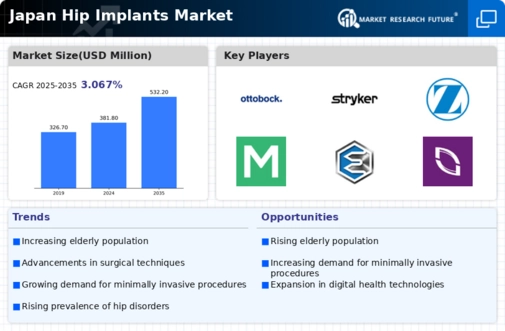Rising Healthcare Expenditure
Japan's healthcare expenditure has been on the rise, which is a significant driver for the hip implants market. With an aging population and increasing healthcare needs, the government and private sectors are investing more in medical technologies and surgical procedures. Recent data indicates that healthcare spending in Japan has increased by approximately 10% annually, reflecting a commitment to improving patient care. This financial support enables hospitals to acquire advanced hip implant technologies and expand their surgical capabilities. Consequently, the hip implants market is likely to experience robust growth as healthcare facilities enhance their offerings to meet the rising demand.
Innovations in Implant Materials
Advancements in materials science are significantly influencing the hip implants market. The introduction of innovative materials, such as highly cross-linked polyethylene and ceramic coatings, enhances the durability and biocompatibility of implants. These innovations are crucial in reducing wear rates and improving patient outcomes. In Japan, the market has seen a shift towards these advanced materials, with a reported increase in their adoption by approximately 25% over the past few years. This trend not only improves the longevity of implants but also aligns with the growing patient preference for minimally invasive procedures. Consequently, the hip implants market is likely to benefit from these technological advancements.
Rising Incidence of Hip Disorders
The increasing prevalence of hip disorders in Japan is a primary driver for the hip implants market. Conditions such as osteoarthritis and rheumatoid arthritis are becoming more common, particularly among the aging population. According to recent health statistics, approximately 30% of individuals over 65 years old in Japan experience some form of hip-related issues. This trend necessitates surgical interventions, leading to a higher demand for hip implants. Furthermore, the Japanese healthcare system is adapting to these needs by enhancing access to orthopedic surgeries, which is likely to further stimulate market growth. The hip implants market is thus positioned to expand as more patients seek effective solutions for their hip disorders.
Increased Awareness of Joint Health
There is a growing awareness among the Japanese population regarding joint health and the importance of early intervention for hip-related issues. Educational campaigns and health programs are encouraging individuals to seek medical advice sooner, which is likely to lead to an increase in elective surgeries. This heightened awareness is reflected in a reported 20% rise in consultations for hip disorders in recent years. As more patients become informed about treatment options, the demand for hip implants is expected to rise correspondingly. Thus, the hip implants market stands to gain from this cultural shift towards proactive health management.
Government Initiatives for Healthcare Improvement
The Japanese government is actively promoting initiatives aimed at improving healthcare services, which directly impacts the hip implants market. Policies that support advanced surgical techniques and the integration of new technologies into healthcare facilities are being implemented. For instance, the government has allocated substantial funding to enhance orthopedic care, which is expected to increase the number of hip surgeries performed annually. This proactive approach may lead to a projected growth rate of 15% in the hip implants market over the next five years. As a result, the hip implants market is poised to thrive under these supportive governmental measures.

















Leave a Comment